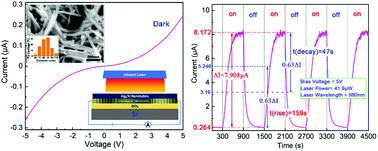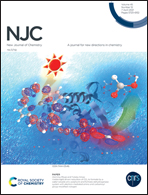Simple synthesis of crooked Ag2Te nanotubes and their photoelectrical properties
Abstract
In recent decades, silver telluride has been considered as an excellent thermoelectric material, but its photoelectric conversion performance has received little attention. In this study, we synthesized uniform crooked Ag2Te nanotubes by a homogeneous precipitation method without surfactant under mild conditions. The photoelectrical properties of the Ag2Te nanotube film-based photodetectors were also investigated. In the specific process, TeO2 and AgNO3 were used as the raw materials, KOH as an alkaline environmental provider, L-ascorbic acid as the reducing agent and ethylene glycol as the solvent. The morphology of the products can be regulated effectively by adjusting the amount of reducing agent and the reaction temperature. Ag2Te nanotubes with ∼100 nm outer diameter, ∼15 nm inner diameter and ∼4 μm length were prepared with an aqueous solution of 5.0 mL L-ascorbic acid and 6.7 mL AgNO3 at 120 °C for 2 h. Under illumination of 980 nm pulsed incident infrared light with a period of 600 s under room temperature, laser power of 41.9 μW and bias voltages of +5.0 V, the photodetector exhibits a photocurrent of 7.908 μA, an on/off ratio of 30.95 and a responsivity of 189 mA W−1. All these parameters are superior to the recently reported performance of Ag2Te nanocrystal-based photodetectors.



 Please wait while we load your content...
Please wait while we load your content...